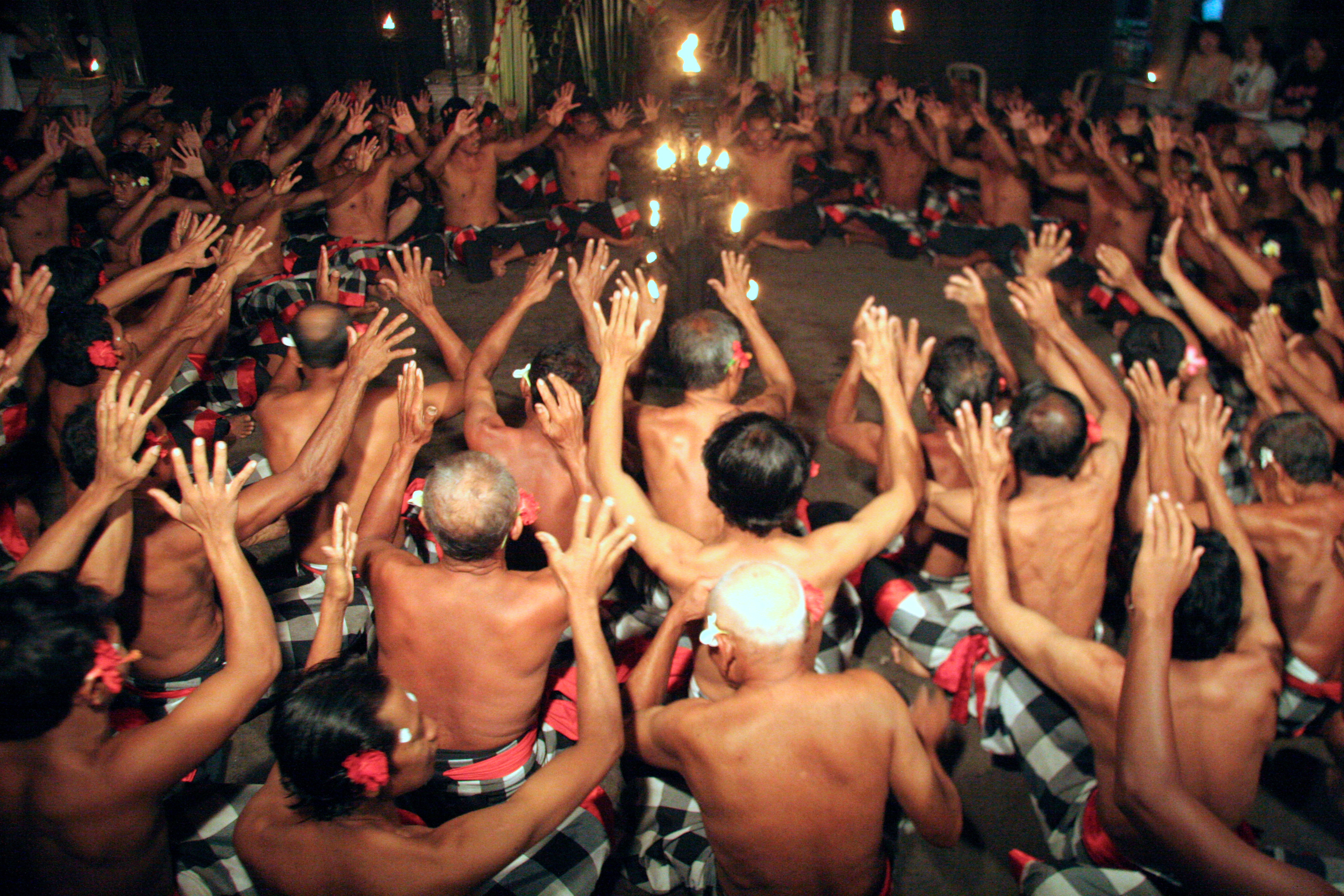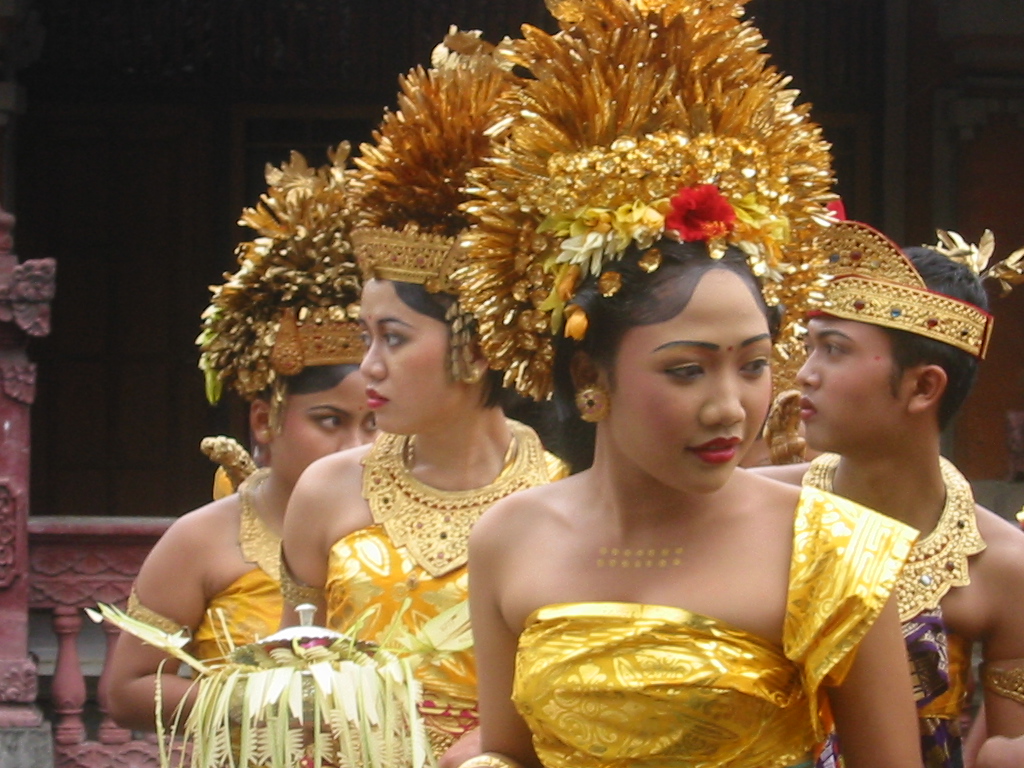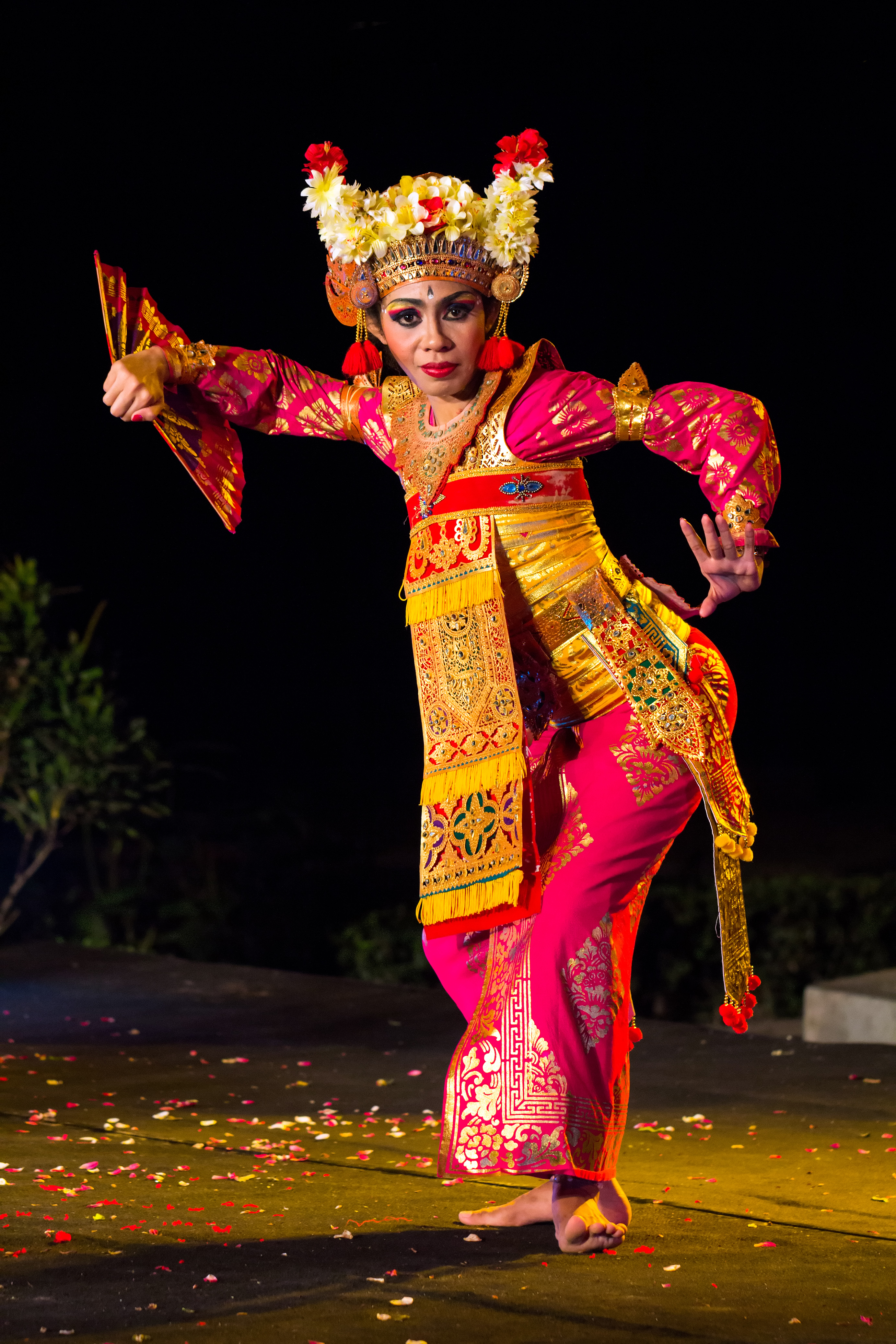Balinese Dance on:
[Wikipedia]
[Google]
[Amazon]

 Balinese dance (; ''(igélan Bali)'') is an ancient
Balinese dance (; ''(igélan Bali)'') is an ancient
 In
In
 In Bali there are various categories of dance, including epic performances such as the omnipresent ''
In Bali there are various categories of dance, including epic performances such as the omnipresent ''
 Bali dancers learn the craft as children, they play Balinese music. They are taught to dance with their hands before they can walk. Official training as a Bali dancer starts as young as 7. In Balinese dance, the movement is closely associated with the rhythms produced by the
Bali dancers learn the craft as children, they play Balinese music. They are taught to dance with their hands before they can walk. Official training as a Bali dancer starts as young as 7. In Balinese dance, the movement is closely associated with the rhythms produced by the
File:Bali-Danse 0726a.jpg, A man dancing Balinese ''Barong''.
File:Tari Tenun Nyoman Hendra Adhi Wibowo.jpg, Balinese ''Tari Tenun'' (weaving dance) mass dance, performed by hundreds of dancers.
File:Pendet Dance.jpg, Balinese ''Tari pendet'', performed by hundreds of dancers.
File:Learn to Dance.jpg, Balinese people have learned to dance since childhood. Balinese dance is a living tradition incorporated within the everyday way of life.
File:Bali-Danse 0705a.jpg, '' Baris dance''
File:17 Years of Sekar Jepun 2014-11-01 72.jpg, '' Condong''
File:Barisan Penari Bali.jpg, '' Legong''
File:Tari Pendet.jpg, '' Pendet''
File:Barong, Batubulan Village, Bali 1601.jpg, '' Barong dance''
File:Bali-Danse 0710a.jpg, '' Topeng dance''
File:17 Years of Sekar Jepun 2014-11-01 42.jpg, '' Cendrawasih dance''
File:Sang Hyang Jaran.jpg, ''

 Balinese dance (; ''(igélan Bali)'') is an ancient
Balinese dance (; ''(igélan Bali)'') is an ancient dance
Dance is an The arts, art form, consisting of sequences of body movements with aesthetic and often Symbol, symbolic value, either improvised or purposefully selected. Dance can be categorized and described by its choreography, by its repertoir ...
tradition that is part of the religious and artistic expression among the Balinese people
The Balinese people (, ) are an Austronesian ethnic group native to the Indonesian island of Bali. The Balinese population of 4.2 million (1.7% of Indonesia's population) live mostly on the island of Bali, making up 89% of the island's population ...
of Bali
Bali (English:; Balinese language, Balinese: ) is a Provinces of Indonesia, province of Indonesia and the westernmost of the Lesser Sunda Islands. East of Java and west of Lombok, the province includes the island of Bali and a few smaller o ...
island, Indonesia
Indonesia, officially the Republic of Indonesia, is a country in Southeast Asia and Oceania, between the Indian Ocean, Indian and Pacific Ocean, Pacific oceans. Comprising over List of islands of Indonesia, 17,000 islands, including Sumatra, ...
. Balinese dance is dynamic, angular, and intensely expressive. Balinese dancers express the stories of dance-drama through bodily gestures including gestures of fingers, hands, head, and eyes.
There is a great richness of dance forms and styles in Bali; and particularly notable are those ritualistic dance dramas which involve Rangda, the witch, and the great beast Barong. Most of the dances in Bali are connected to Hindu
Hindus (; ; also known as Sanātanīs) are people who religiously adhere to Hinduism, also known by its endonym Sanātana Dharma. Jeffery D. Long (2007), A Vision for Hinduism, IB Tauris, , pp. 35–37 Historically, the term has also be ...
or traditional folk rituals, such as the Sanghyang
() is a traditional sacred Balinese dance originated from the Indonesian island of Bali. It is based on the premise that an unseen force enters the body of an entranced performer. The force, identified as '' hyang'', is an important type of ...
Dedari sacred dance
Sacred dance is the use of dance in religious Ceremony, ceremonies and rituals, present in most religions throughout history and prehistory. Its connection with the human body and fertility has caused it to be forbidden by some religions; for exa ...
that invokes benevolent hyang
''Hyang'' (Kawi language, Kawi, Sundanese language, Sundanese, Javanese language, Javanese, and Balinese language, Balinese) is a representation of the King of the gods, supreme being, in ancient Mythology of Indonesia, Java and Bali mythology. T ...
spirits, believed to possess the dancers in a trance
Trance is a state of semi-consciousness in which a person is not self-aware and is either altogether unresponsive to external stimuli (but nevertheless capable of pursuing and realizing an aim) or is selectively responsive in following the dir ...
state during the performance. Other Balinese dances are not linked to religious rituals and are created for certain occasions or purposes, such as the Baris or Pendet welcoming dances and Joged dance, which is a social dance for entertainment.
Recognition and conservation
During the Intergovernmental Committee for the Safeguarding of the Intangible Cultural Heritage convention from 29 November to 4 December 2015 inWindhoek
Windhoek (; ; ) is the capital and largest city of Namibia. It is located in central Namibia in the Khomas Highland plateau area, at around above sea level, almost exactly at the country's geographical centre. The population of Windhoek, which ...
, Namibia, UNESCO
The United Nations Educational, Scientific and Cultural Organization (UNESCO ) is a List of specialized agencies of the United Nations, specialized agency of the United Nations (UN) with the aim of promoting world peace and International secur ...
recognized three genres of traditional dance in Bali, Indonesia, as Intangible cultural heritage
An intangible cultural heritage (ICH) is a practice, representation, expression, knowledge, or skill considered by UNESCO to be part of a place's cultural heritage. Buildings, historic places, monuments, and artifacts are cultural property. In ...
. The three genres include ''Wali'' (sacred dance
Sacred dance is the use of dance in religious Ceremony, ceremonies and rituals, present in most religions throughout history and prehistory. Its connection with the human body and fertility has caused it to be forbidden by some religions; for exa ...
s), ''Bebali'' (semi-sacred dances), and ''Balih-balihan'' (dances for entertainment purposes). Balinese dance has been proposed since 2011, and was officially recognized in 2015.
The three genres are represented by nine dances, which describe their function and living tradition in the Balinese community, they are:
;''Wali'' Sacred Dances
# Rejang (Klungkung District). Sacred ceremonial dance by young women in traditional ceremonial dress,
# Sanghyang Dedari (Karangasem District). Sacred trance dance to counteract negative supernatural forces. Performed by two young girls.
# Baris Upacara (Bangli District) religious dances convey a heroic spirit danced by even numbers of male dancers.
;
;''Bebali'' Semi Sacred Dances
# Topeng Sidhakarya/Topeng Pajegan (Tabanan District). Performed by masked dancers to neutralize the evil spirits.
# Gambuh dance drama (Gianyar District). Formerly royal theatrical performance, now accompaniment to ceremonies, by 25-40 dancers.
# Wayang Wong Dance Drama (Buleleng District). Combines dance, epic drama, and music.
;
;''Balih-balihan'' Entertainment Dances
# Legong Kraton (Denpasar City). Dance by 2 or 3 girls. Developed from Sanghyang Dedari, and Gambuh.
# Joged Bumbung (Buleleng District). A popular social dance by couples, during harvest season or on important days.
# Barong Ket "Kuntisraya" (Badung District). Represents a fight between two mythological characters, Barong in the form of a lion symbolizing goodness, and Rangda, an evil witch.
Significance
Hinduism
Hinduism () is an Hypernymy and hyponymy, umbrella term for a range of Indian religions, Indian List of religions and spiritual traditions#Indian religions, religious and spiritual traditions (Sampradaya, ''sampradaya''s) that are unified ...
, dance is an accompaniment to the perpetual dissolving and reforming of the world. The creative and reproductive balance is often personified as Shiva
Shiva (; , ), also known as Mahadeva (; , , Help:IPA/Sanskrit, ɐɦaːd̪eːʋɐh and Hara, is one of the Hindu deities, principal deities of Hinduism. He is the God in Hinduism, Supreme Being in Shaivism, one of the major traditions w ...
's wife, Durga
Durga (, ) is a major Hindu goddess, worshipped as a principal aspect of the mother goddess Mahadevi. She is associated with protection, strength, motherhood, destruction, and wars.
Durga's legend centres around combating evils and demonic ...
, sometimes called Uma, Parvati
Parvati (, , IPA: /Sanskrit phonology, pɑɾʋət̪iː/), also known as Uma (, , IPA: Sanskrit phonology, /ʊmɑː/) and Gauri (, , IPA: /Sanskrit phonology, gə͡ʊɾiː/), is one of the principal goddesses in Hinduism, revered as the Devi, ...
, or Kali
Kali (; , ), also called Kalika, is a major goddess in Hinduism, primarily associated with time, death and destruction. Kali is also connected with transcendental knowledge and is the first of the ten Mahavidyas, a group of goddesses who p ...
. This has significance in Balinese Hinduism
Hinduism () is an Hypernymy and hyponymy, umbrella term for a range of Indian religions, Indian List of religions and spiritual traditions#Indian religions, religious and spiritual traditions (Sampradaya, ''sampradaya''s) that are unified ...
since the common figure of Rangda is similar in many ways to Durga
Durga (, ) is a major Hindu goddess, worshipped as a principal aspect of the mother goddess Mahadevi. She is associated with protection, strength, motherhood, destruction, and wars.
Durga's legend centres around combating evils and demonic ...
.
Variants
 In Bali there are various categories of dance, including epic performances such as the omnipresent ''
In Bali there are various categories of dance, including epic performances such as the omnipresent ''Mahabharata
The ''Mahābhārata'' ( ; , , ) is one of the two major Sanskrit Indian epic poetry, epics of ancient India revered as Smriti texts in Hinduism, the other being the ''Ramayana, Rāmāyaṇa''. It narrates the events and aftermath of the Kuru ...
'' and ''Ramayana
The ''Ramayana'' (; ), also known as ''Valmiki Ramayana'', as traditionally attributed to Valmiki, is a smriti text (also described as a Sanskrit literature, Sanskrit Indian epic poetry, epic) from ancient India, one of the two important epics ...
''.
Certain ceremonies at village temples feature a special performance of a dance-drama, a battle between the mythical characters Rangda, the witch representing evil, and Barong, the lion or dragon, representing good. This type of performance was traditionally featured during outbreaks of epidemic diseases which were believed by the people to be a result of a disturbance in the balance of the 'good and bad forces', which were represented by the Rangda and the Barong. The battle usually reconciles in harmony or balance of the Rangda and the Barong, instead of a defeat of the evil.
Among the dance traditions in Bali are:
* Barong, king of the spirits
* Baris war dances
* Cendrawasih, the bird of paradise
* Condong, a basic dance, preface to Legong
* Legong, a refined dance
* Kecak, the Ramayana monkey chant dance
* Janger, a sitting dance with swaying movements
* Pendet, a simple dance performed before making an offering at a temple
*Tenun, a dance that describes women weaving
Weaving is a method of textile production in which two distinct sets of yarns or threads are interlaced at right angles to form a fabric or cloth. Other methods are knitting, crocheting, felting, and braiding or plaiting. The longitudinal ...
the cloth
* Topeng, a mask dance
Traditionally, sacred dances can only be performed in temples. However, new choreographies have been created due to the demand from tourists. One example, Tari Sekar Jagat (Tari means dance in the Balinese language), is a relatively new choreography that has become popular. In the newer creations, choreographers have more freedom over the moves. They used new moves that were considered 'improper' for the sacred dances. For example, in Tari Sekar Jagat, there is a movement when the dancers hold the Dulang below their shoulders. This ceremonial pedestal, which may be wooden or ceramic, is normally held high following its sacredness. Below shoulder level but above the navel represents an ordinary or everyday state.
Technique
 Bali dancers learn the craft as children, they play Balinese music. They are taught to dance with their hands before they can walk. Official training as a Bali dancer starts as young as 7. In Balinese dance, the movement is closely associated with the rhythms produced by the
Bali dancers learn the craft as children, they play Balinese music. They are taught to dance with their hands before they can walk. Official training as a Bali dancer starts as young as 7. In Balinese dance, the movement is closely associated with the rhythms produced by the gamelan
Gamelan (; ; , ; ) is the traditional musical ensemble, ensemble music of the Javanese people, Javanese, Sundanese people, Sundanese, and Balinese people, Balinese peoples of Indonesia, made up predominantly of percussion instrument, per ...
, a musical ensemble specific to Java and Bali. Multiple levels of articulations in the face, eyes, hands, arms, hips, and feet are coordinated to reflect layers of percussive sounds.
The number of codified hand positions and gestures, the mudra
A mudra (; , , "seal", "mark", or "gesture"; ) is a symbolic or ritual gesture or pose in Hinduism, Jainism and Buddhism. While some mudras involve the entire body, most are performed with the hands and fingers.
As well as being spiritual ges ...
s, is higher in India than in Java or Bali. It has been speculated that they have been forgotten as the dance was transmitted from India to Java. Hand positions and gestures are nonetheless as important in Javanese and Balinese dance as in India.''A Dictionary of Theatre Anthropology: The Secret Art of the Performer'' by E. Barba (2005) p.156 Whether in India, Indonesia, or Cambodia
Cambodia, officially the Kingdom of Cambodia, is a country in Southeast Asia on the Mainland Southeast Asia, Indochinese Peninsula. It is bordered by Thailand to the northwest, Laos to the north, and Vietnam to the east, and has a coastline ...
, hands have a typically ornamental role and emphasize the dance's delicate intricacy.
Gallery
Sanghyang
() is a traditional sacred Balinese dance originated from the Indonesian island of Bali. It is based on the premise that an unseen force enters the body of an entranced performer. The force, identified as '' hyang'', is an important type of ...
''
File:17 Years of Sekar Jepun 2014-11-01 52.jpg, '' Kebyar duduk''
File:Rejang Adat.jpg, '' Rejang dance''
File:17 Years of Sekar Jepun 2014-11-01 32.jpg, '' Oleg dance''
File:17 Years of Sekar Jepun 2014-11-01 46.jpg, '' Panyembrama''
See also
* Dance in Indonesia * Javanese dance * Sundanese dance * Dance of Cambodia * Dance of Thailand * Theatre in Bali *Hinduism in Bali
Hinduism is the Religion in Indonesia, third-largest religion in Indonesia, based on civil registration data in 2023 from Ministry of Home Affairs (Indonesia), Ministry of Home Affairs, is practised by about 1.68% of the total population, and ...
* Dance in mythology and religion
* List of basic dance topics
* List of dance style categories
This is a list of dance categories, different types, styles, or genres of dance.
For older and more region-oriented vernacular dance styles, see List of ethnic, regional, and folk dances by origin.
Belly dance
*Belly dance
*Raqs Sharqi
*Turkis ...
* List of dances
This is the main list of dances. It is a non-categorized, index list of specific dances. It may also include dances which could either be considered specific dances or a family of related dances. For example, ballet, ballroom dance and folk dance c ...
References
External links
* {{DEFAULTSORT:Balinese Dance Balinese culture Dances of Indonesia Dances of Bali Ritual dances Partial squatting position